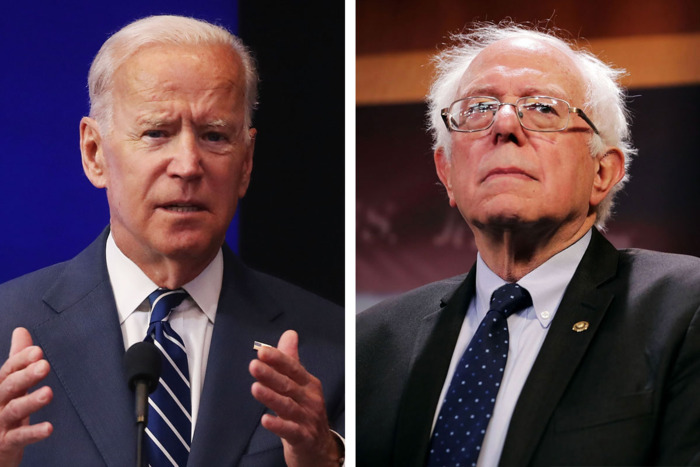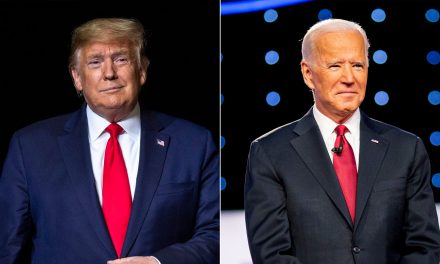Image Credits: Photo: Getty Images.
At this early stage, I’m not overly interested in theoretical 2020 head-to-head polls of various Democrats’ chances against Donald Trump, but I’ll take in the information and give it some degree of weight. The news of out Michigan is encouraging for the left, as the president is trailing in every heat they tested. Joe Biden and Bernie Sanders performed best in the just-released Glengariff Group public opinion survey. Notably, they both cracked 50 percent with identical 53-41 margins.
They also tested Pete Buttigieg, Kamala Harris, and Elizabeth Warren. Each of them topped out at 47% and led Trump only within the margin of error. Given the low sample size (n=600), I don’t put any stock in the subgrouping, but there are two findings from the poll that I think are highly relevant to understanding the state of play in Michigan and likely in many of the more competitive states.
First, there’s this:
Trump polled particularly poorly with African-American and female voters and would be well served to target women in Oakland and Macomb counties that turned toward Democrats in 2018, [pollster Richard] Czuba said.
“Southeast Michigan women — we’ve seen this now for a year and a half — continue to be a mammoth problem for the Republican Party,” he said.
This is the suburban area of Detroit, and it’s a mix of white working class voters, many from the auto industry, and more highly educated white professionals. It’s similar to other important suburbs like those outside Milwaukee, Cleveland, Pittsburgh, and Philadelphia. Suburban women are becoming “a mammoth problem” for the GOP, and the advances the Republican Party is making against women’s reproductive freedom are only going to exacerbate the problem. This isn’t a shocking finding, but it’s another data point to confirm the common wisdom on this point.
Secondly, there’s the measure of voter engagement:
“What we saw in Michigan in 2016 wasn’t this giant surge of Trump voters — it was an absolute apathy on behalf of independents and leaning Democrats to vote,” Czuba said. “We’re seeing the exact opposite heading into 2020.”
…All told, the poll suggests historic levels of motivation among Michigan voters more than nine months out from the March primary and nearly 17 months until the general election.
Asked to rate their motivation on a scale of 1 to 10, Michigan voters averaged a 9.5.
The enthusiasm was consistent across the political spectrum, with strong Republicans and Democrats both reporting an average motivation score of 9.6, compared with 6.5 and 6.7 in October 2016.
As I noted above, I put little stock in the cross tabs of any poll with a low sample size, but the independents in this survey did prefer Joe Biden over the others.
Biden leads Trump 53%-41%, with 4% undecided, and was the only top candidate from either party with favorable name identification, including among coveted independents. He polled particularly well with female voters despite recent accusations that the 76-year-old Democrat made women uncomfortable by violating their personal space.
Biden “is the only candidate for president on either side of the ballot that independents like, and that is a dramatic finding,” Czuba said.
For supporters of Bernie Sanders, they can be encouraged that he did best with white working class voters, which may surprise people who think that’s Biden’s lane. Either model (independents or white working class) can work, and a combination of both would be best, but they’re each different in their own way from a base mobilization strategy.
Arguing against a base mobilization strategy is the fact that partisans on both sides are showing off-the-charts enthusiasm in the early summer of the year before the voting. All indications are that Trump is very good at getting people to pay attention to and care about politics. He gets high ratings even if he doesn’t get good ratings. What this probably means is that it’s a poor allocation of resources to focus on getting out the partisan vote. They will be there with bells on to vote without any prodding by party operatives. This is not going to be a battle of the two bases, but rather a persuasion election fought out in the middle.
The two leading Democrats would go about attacking the middle in different ways. Each would seek to eat into Trump’s white working class base, but Sanders might have more success and he’d certainly be more reliant on them than Biden. Biden would have a much easier time making a case to white professionals who aren’t looking for a socialist revolution but have seen quite enough of Trump. In this poll, at least, the result comes out the same even if (depending on which of the two you examine) the shape of the electorate is considerably different .
Were this to hold true, one difference between a Sanders and Biden victory would be the geographic distribution of the vote. Sanders would pull fewer votes out of the suburbs but make up it for it by doing less badly in red areas. This is a generally desirable result for the Democrats, as both Congress and the state legislatures lean artificially to the right due to the packing of Democratic votes into urban/suburban areas. On the other hand, there are lot of freshmen Democrats who were elected by narrow margins in historically Republican suburban districts, and their chances of reelection would be better with the Biden distribution.
I acknowledge the danger of drawing firm conclusions from a survey like this one, which is why I place more emphasis on the finding of sky-high voter interest than anything else. It confirms my belief that going after low-propensity voters is not the best way for the Democrats to win this election. That has been true in the past, but this time is likely to be different. The Democrats are more likely to win by capturing the middle, which isn’t the same thing as some centrist point on the ideological scale. The middle is the group of the people who have the potential to vote either way. Some are Obama-Trump voters, some are Romney-Clinton voters, some are traditional white union workers and non-college educated working class voters in general.
Unfortunately, these voters are unlikely to decide who will win the party’s nomination. On the other hand, the partisan Democrats seem to be in a pragmatic mood, so it doesn’t look like proving yourself to be the most out-of-the-mainstream true blue liberal is going to be a slam dunk winning strategy. In any case, assuming people agree that there’s a wide ideological gap between Biden and Sanders, people should look at this survey’s results and conclude that a pursuit of the middle still allows for a lot of room to maneuver for the candidates. They both pull 53-41 in the poll, so maybe going after the middle isn’t a game for sell-out centrists after all.







